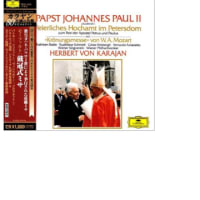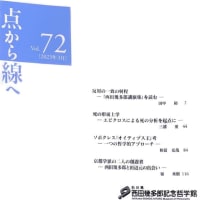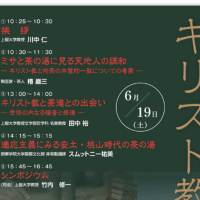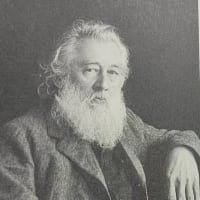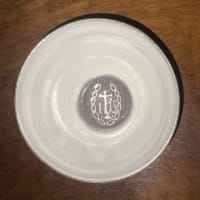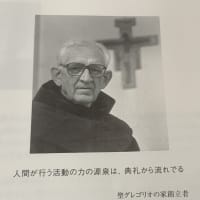Moreover there is a further argument against Whitehead's type of gravitational theory as suggested by Schild.26 According to this argument, we must abandon the presupposition of "flat" space, if we accept the uniform occurrence of the gravitational redshift. The argument is as follows:
Suppose that a light signal with the frequency v' is emitted at the gravitational potential V, and it is observed as a light with the frequency v at the potential
 .
. As the light loses energy during the movement against the gravitational field, becomes smaller than ' according to the equation:

This is the formula for the gravitational redshift. If we consider the light as a wave movement then the above formula involves an apparent contradiction, for it is unreasonable that

since wave crests cannot originate or disappear between sender and receiver. This contradiction is resolved by assuming that time flows at different rates at different levels in a gravitational field. If a clock resting at level V measures a time interval s' for n oscillations of the wave and if a clock resting at level measures a time-interval s for n oscillations, then

Substituting this into the aforementioned formula, we get:

This is the formula for the gravitational time dilatation.
If we presuppose that space-time is fiat, we find that it is contradictory to the above result of time dilatation. In Minkowski's space-time, the world-lines of two clocks at rest are parallel to the time-axis. Suppose that the stationary gravitational field is parallel to x-axis, and the light signal, emitted from the world-point P with the potential V, is received at the world-point Q with the potential
After the time-interval s', measured along the lower world-line of the clock at the potential V, another light signal with the same frequency is emitted from the world-point Q, and received at B which lies at the higher world-line of the clock at the potential
As the whole setup is stationary, PA and QB are parallel to each other, and PABQ must be a parallelogram. Therefore PQ(s') must be equal to AB(s), which is contradictory to the formula for the gravitational time dilatation. Simple as it is, the above argument shows clearly that the Whiteheadian theory of gravitation needs some modifications in order to explain the uniformity of the gravitational redshift. Of course we can escape form this difficulty simply by postulating as an auxiliary hypothesis that the gravitational field exerts a physical infiuence uniformly on the inner structures of atomic clocks. But such an ad hoc remedy only shows that we had better adopt Einstein's thesis that the gravitational field directly affects the space-time metric. The only alternative is to take what Whitehead called "potential mass impetus", dJ, as measuring the element of proper time along time-like world-lines. This type of modification, as Synge and others showed, makes it possible to deduce the uniform redshift from Whitehead's equations. We can get the same predicted value of redshift as that of Einstein's equations.
But we must bear in mind that the above remedy requires us to reformulate one of the fundamental tenets in Whitehead's theory, i.e., that space-time should have the uniform structure independent of matter. Accepting the influence of gravitation on metrical properties of space-time, we are obliged to ask the following question. To what extent may we admit the effects of matter on space-time and at the same time remain faithful to Whitehead's philosophy of nature?
As was stated in the second section of this paper, Whitehead rejected the priority of matter over space-time. In his philosophy of nature, events are ontologically prior to matter and space-time. Matter is treated as an "adjective" of events, and cannot influence the essential properties of space-time which should be decided only by the interrelated structures of events. The existence of matter only affects the accidental attributes of space-time. So there are two alternatives concerning the status of metric properties. One is what Whitehead adopted in his formulation of physical theory: the metrical properties of space-time are independent of matter. But this choice is untenable if we take seriously the aforementioned results of experiments. So we must take the other alternative. i.e. the metrical properties of space-time are indeed affected by the existence of matter, but the topological properties are independent of matter. It must be noticed that Whitehead himself was absorbed in the topology of events as the "theory of extensive continuum" in his later philosophy of nature.27 For example, he tried to define the concept of "straightness" or "flatness" without relying on any metrical property, but only through the interrelated structures of extended regions. So the idea of topology without metric as the determinant of space-time may be called Whiteheadian, though it is not explicitly stated in The Principle of Relativity where he stresses the uniformity of metrical structure.
If we adopt the idea of the topological priority of events over matter, we can restrict the extent to which the distribution of matter exerts influence on the topology of space-time. On the other hand, if we think that the structure of space-time totally depends on the distribution of matter, we are confronted with a queer situation, which Goedel called "the Ideality of Time" in one of the solutions of Einstein's equation;(28)i.e. Einstein's theory is consistent with the cosmological model where "for every possible definition of a world time one could travel into regions of the universe which are passed according to that definition." Einstein himself admitted in his response to Goedel that the directionality of time cannot be determined within the framework of general relativity, for the topological structure of the universe might be determined by matter in such a way that the time-like world-line is found to be closed.29 As Whitehead's philosophy of nature insists on "the reality of time", i.e., the reality of events which cannot be repeated, it would be productive for the future development that a new version of Whiteheadian theory of relativity adopts the idea of topological priority of events over matter, instead of the uniformity of a space-time metric .











